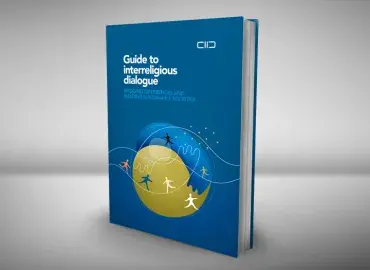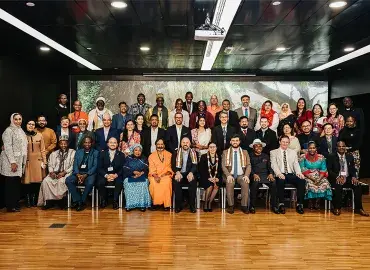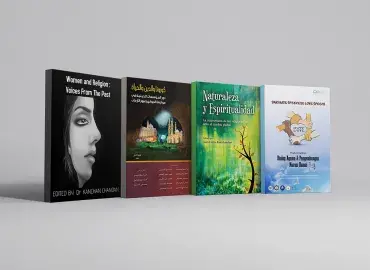New Book by a KAICIID Fellow Explores Possibilities of Pictorial Art for Interreligious Dialogue
The Rothko Chapel in Houston, Texas is not necessarily what you think it is. Unless, of course, you thought it was a decidedly nondenominational, octagonal chapel adorned with fourteen black, but colour-hued, paintings by U.S. artist Mark Rothko.
Welcoming some 100,000 visitors of many faiths — and no faith — from across the world each year, the aim of the chapel is, “to create opportunities for spiritual growth and dialogue that illuminate our shared humanity and lead to a world in which all are treated with dignity and respect.” Quite frequently, after stepping outside the chapel, visitors will often ask each other, “what did you see in there?”
It is those kinds of conversations that Roman Catholic theologian and 2020 KAICIID Fellow Dr. Christopher Longhurst hopes to prompt with his new book, Pictorial Art for Interreligious Dialogue.
Funded by the KAICIID Fellows Programme, the publication explores the unique usage of pictorial art to undertake interreligious dialogue, presenting a practical guide to help educators learn and teach an effective and enjoyable interreligious dialogue in both academic and informal settings.
From New Zealand to Rome, Morocco to Munich
An expert in theological aesthetics, Longhurst first came up with the idea in Vienna at a training of the 2020 KAICIID Fellows Programme. Through his own observations and inspired by conversations with other Fellows, Longhurst knew the time had come to write the handbook.
But his journey into teaching interreligious dialogue through pictorial art began years ago, in Rome. A native of Napier, Aotearoa New Zealand, Longhurst studied art and theology for 17 years at the Vatican Museums. Taking in Raphael’s “The School of Athens” (1509-1511) and Caravaggio’s “Deposition,” (1603-1604) Longhurst was taken up by how multiple forms of art — buildings, statues, paintings — conveyed religious messages and inspired spiritual conversations.
“People of all — or no — religious background come to works of art and can speak to one another about them,” said Longhurst, “and this led me to think about how pictorial art might help open up deep, theological conversations between people of multiple faith traditions.”
“Mediated dialogue is always great, and art is a medium that naturally provokes deep feeling and deep discussions,” he said.
Spending time comparing iconoclastic art in Germany and Switzerland with arabesque patterns in North Africa, Longhurst came to believe that pictorial art — regardless of its origins — could prove particularly helpful in sparking fruitful dialogue.
But it wasn’t only explicitly religious creations that motivated Longhurst to explore art’s theological intimations. In fact, he was especially moved by so-called “secular” pieces, modern and abstract art.
Abstract art “offers access to a wider common ground for interreligious dialogue because of its capacity to exhibit theological topics that traverse diverse religions,” wrote Longhurst. “They guide you into searching the same world in different ways,” he said. “Artwork speaks to us individually,” said Longhurst, “but when two, three, or more people stand in front of an artwork it becomes a broader media conversation.”
How pictorial art helps create dialogue
To better steward and guide that conversation, Longhurst developed the Structured Arts-based Educational Dialogue (SAED) method.
The benefit of the method is that it directly focuses on the artwork, but also involves the person who is taking meaning from the artwork’s content or subject matter, Longhurst said.
This kind of dialogue creates a safe and enjoyable space for dialoguers that transcends taste, trepidation, and negativity.
“Dialoguers can be of diverse religious beliefs, faith traditions, and cultural backgrounds or of similar religious backgrounds or belief systems,” said Longhurst. “They can also come together in various ways: one-on-one, in small groups and circles, or in educational settings,” he said.
“It’s perhaps the safest space for dialogue,” said Longhurst, “because it’s almost impossible to offend one another if you’re talking to an art piece. It doesn’t talk back. Even if you don’t like the art piece — or disagree with someone’s interpretation — it just leads to more conversation.”
“Better yet,” said Longhurst, “viewing art itself is, arguably, enjoyable and so the dialogue becomes a pleasant pastime rather than a context for anxiety or apprehension.” He said, “this not only expands our understanding of diversity, but it creates relationships, even friendships. It’s not just about learning, but also building genuine connections through art. The possibilities are almost endless.”
Longhurst believes different kinds of art can lead to different kinds of conversations. Whether it’s pure abstract art, abstract works with content, or realistic, narrative, or figural images, pictorial art can generate a diverse range of dialogues.
Over pieces such as Jan Richardson’s “A Spiral Shaped God” (the book’s cover image), Piet Modrian’s “Composition with Yellow and Blue” (1932), or Kazuya Akimoto’s “Abstract Fluid Virgin Mary” (2008) discussants can consider the meaning of colors and shapes, exploring ideas like atman — the spiritual life principle of the universe according to Hindu traditions — or varying concepts of purity, creation, or divinity across religions. The direction those dialogues take is up to the facilitator, he said.
“A teacher can make a decision to select different artwork for different scenarios, different purposes,” he said, “different works of art that speak to the different worldviews and life experiences.”
Longhurst saw these dynamics at work when he piloted the method at one of the monthly meetings of a local Interfaith Council in Aotearoa New Zealand. Using the “circle process” — a group of eight to ten people of diverse faith traditions sitting in a circle for intentional dialogue — Longhurst facilitated a conversation around an abstract work of art.
“It worked wonderfully,” he said, “there was no direct conversation with people, it was mediated through the art, which each person brings their theological ideas and experiences to. When this happens, it’s almost beyond criticism.”
Now that the book is published and available free to download thanks to KAICIID’s support, Longhurst is looking forward to seeing how educators and dialogue facilitators create and carry out their own scenarios for dialogue through pictorial art.
“Imagine,” he said, “taking the book to an art gallery with a diverse group and applying it with students or a religiously diverse group of people, asking some of those questions.” Longhurst said, “The possibilities are almost endless.”
Interreligious dialogue is vital to bridging divisions in an increasingly turbulent world, a new guide from the International…
Members of the 2020 KAICIID Fellows Programme have celebrated their graduation at a ceremony in Lisbon.
…
Publishing a book is no minor feat. Although many people may have an idea — and may even set out to write it — getting a book…




